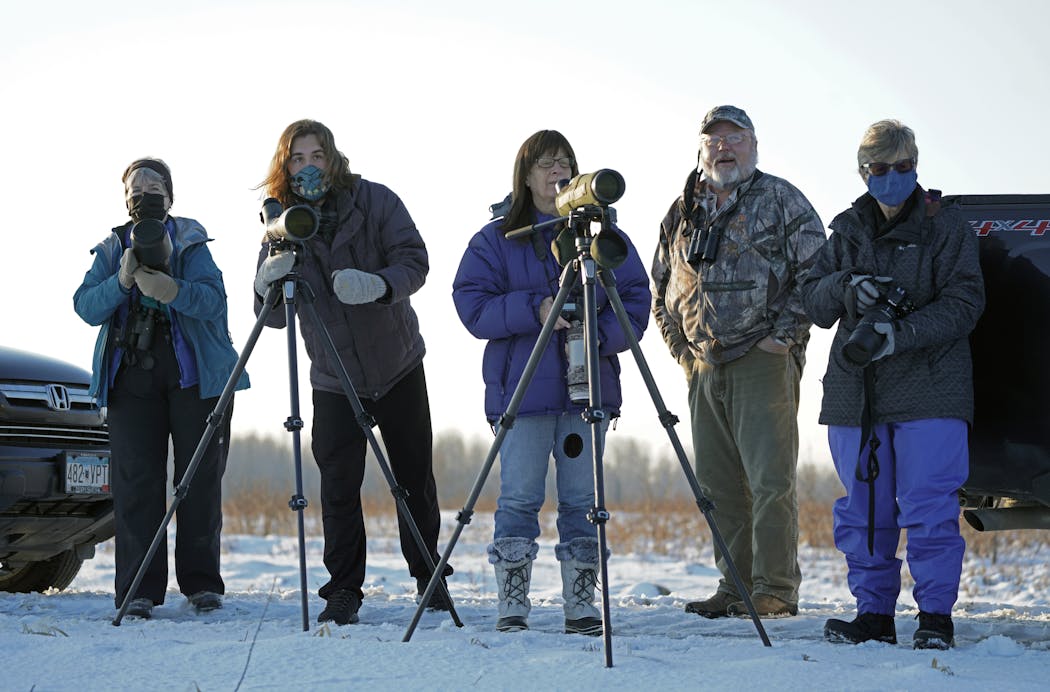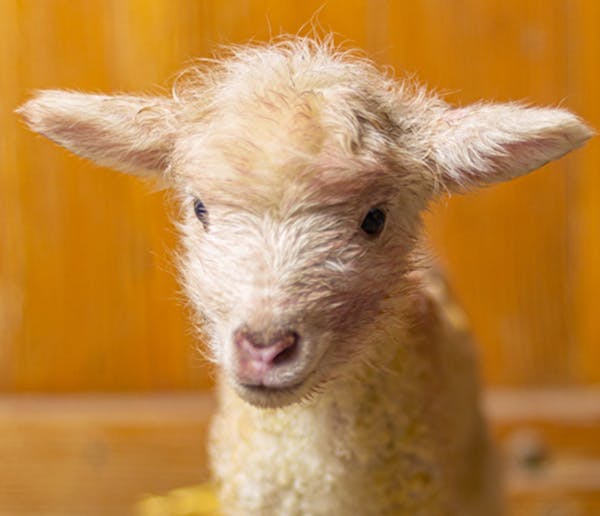What would induce someone to drive halfway across the country to northern Minnesota? During the coldest time of year? In the middle of a pandemic?
The great gray owl.
One of the world's largest owls — standing nearly 3 feet tall and with a wingspan of up to 5 feet — the great gray is a rare and beautiful sight that's been known to elicit victory dances and even draw tears.
The owls once again made their appearance this winter in Sax-Zim Bog in rural St. Louis County. And intrepid bird watchers like Basco Eszeki were there to see it.
Great grays are on Eszeki's bucket list. So the 67-year-old retiree made the 1,200-mile, one-way drive from Silver Springs, Md., to Minnesota in early February.
"To see an awesome bird like a great gray owl — on one level it's an adrenaline rush like nothing else I get these days," he said. "It's something akin to a religious experience."
After coming all this way, Eszeki wasn't about to leave a sighting to chance. So he hired one of the handful of professional bird guides that work the bog, which has become an international winter destination for bird-watchers.
For the past 30 years, Kim Risen, a guide from rural Aitkin County, has been making a living by helping people find birds in far-flung locations such as Latin America and Southeast Asia. In winter, however, he stays closer to home as birders migrate here to see the great owls of the North Woods.
Risen said that word about Sax-Zim Bog spread rapidly during the winter of 2004-05, when there was an influx (called an "irruption") of hundreds of northern forest owls to northeastern Minnesota. Stories about the presence of great gray, boreal and Northern hawk owls garnered national news, bringing in birders from around the world.
"I guided every day, nearly every day, for three months," said Risen, who owns Naturescape Tours.
Back then, he was one of only three guides in Sax-Zim Bog. Now there are about 10.
Training, timing and driving
The accessibility of the bog adds to its allure, said Risen. Instead of trekking into the forests of Canada, a birder can fly into the Duluth airport and within an hour be in the old-growth tamarack and black spruce bogs, which the owls favor.
But just because the bog is easy to get to doesn't mean it's easy to get around in. Even experienced birders heading into snow-covered back roads of the bog often hire guides, said Judd Brink, the Brainerd-based guide Eszeki hired for three days of birding.
"For first-time people, it can be intimidating," Brink said. "For Sax-Zim, it is really critical to be there at the right time."
Having someone who knows how to drive in the winter is another service that guides provide for out-of-town visitors, said Gregg Severson, a guide from Minneapolis. "Lots of people go off the road in Sax-Zim."
Minnesota guides charge from $175 to $600 for a dawn-to-dusk day of guiding at the bog. What clients ideally get for that is someone with sharp eyes and well-trained ears, someone who's familiar with the birds' territories and who knows what time of day to position a client for the perfect bird photograph. Oh, they also need to know where to find a public restroom.
"I can spot a great gray going 60 miles per hour," said Alex Sundvall, a guide from St. Louis Park who works for Risen. That's a useful skill, because a lot of the birding done at Sax-Zim involves driving from one wooded field to another.
While hiring a guide increases the chance you'll find the bird you're looking for, there's no guarantee.
"It's no different from a fishing guide or a hunting guide," Brink said.
Most bird-watchers seem to understand that wild animals can't be produced on demand.
"It's not a zoo," said Kyle Te Poel, a guide from Stillwater. Still, he admits it's a relief when he's able to spot a particular bird. "The weight's off your shoulders," he said.
In it for the smiles
Sundvall has been a bird-watcher from boyhood. What got him into guiding was helping a friend spot a summer tanager at the Minnesota Landscape Arboretum.
"The look on his face was priceless," Sundvall said. "It was at that moment I knew I wanted to be a guide."
Other guides say they've also been moved by clients' reactions. First-time sightings of a species (or "lifers" as birders call them) — can trigger intense emotions.
"I've seen people brought to tears," said Erik Bruhnke, a birding guide from Duluth.
Last winter, Te Poel was guiding a group of Floridians through the bog. One person was indeed crying — not from happiness, but from the intense cold. Then one of the boreal owls they came to see appeared.
"They forgot how cold they were," Te Poel said. The middle-aged bird-watchers started jumping up and down with childlike joy. "You don't see adults do that kind of thing," he said.
The owl attraction
The 300-square-mile bog is one of the few places in the country to see certain birds, including the boreal chickadee, the black-backed woodpecker and other northern species that winter there. But it's best known for its owls, which are a strong lure.
"A lot of people have a spiritual connection with owls," said Brink.
To Stephanie Sellers, owls are "the most beautiful bird there is." This winter, the Columbus, Ohio, woman flew to Duluth with her husband for a guided tour of the bog.
"Everyone thought we were crazy, but it's my type of thing," she said. "It was exhilarating."
During a February tour of the Sax-Zim Bog, Risen and Sundvall drove a narrow snow-covered road to position three bird photographers from Illinois at the edge of a field to see some sharp-tailed grouse. The birds were preparing for their mating dance, which involves foot stamping, spinning and inflated lilac neck sacs.
"These guys are completely manic," Risen said of the male grouse. "It's like the things we do for love."
Earlier in the day, the group had spotted a Northern hawk owl high up in a tree.
"Any owl, any time, any state, we're happy with," said Kate Scott of Lake Zurich, Ill.
Scott and her friends were happy with the birds they saw and the wealth of information they got from Risen and Sundvall about the region and its birds.
"We've already been talking about coming back," she said.
Next time, though, they'll come in spring and hire a guide to see the warblers.
Richard Chin • 612-673-1775
Judge declines to dismiss lawsuits filed against rapper Travis Scott over deadly Astroworld concert

Summer Movie Guide: Virtually all the movies coming to theaters and streaming from May to Labor Day



